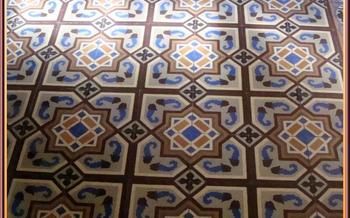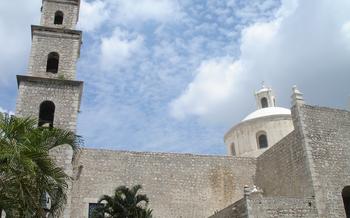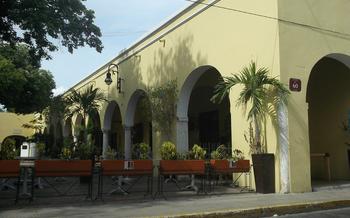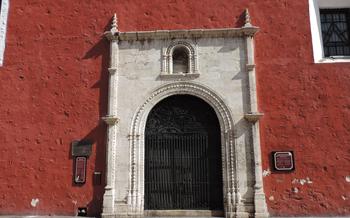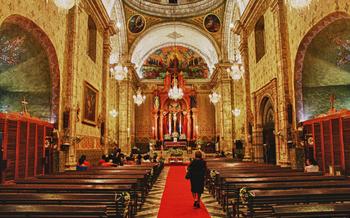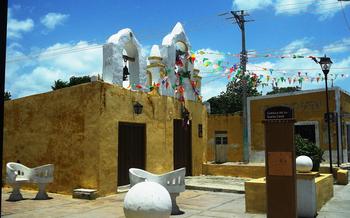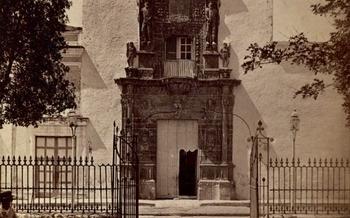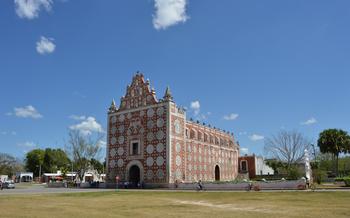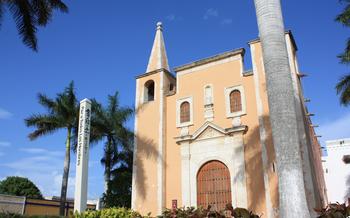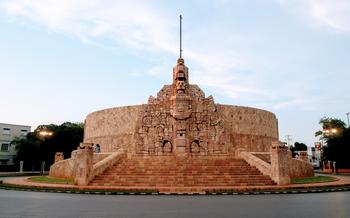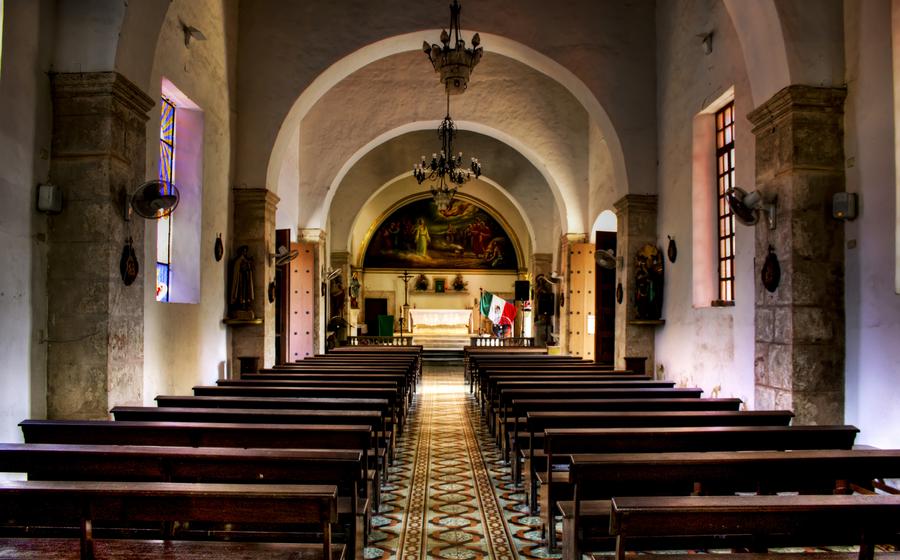
Templo de Santa Lucía
- Historical Significance:
- Architectural Beauty
- Interior Splendor
- Cultural and Religious Significance
- Location and Accessibility
- Opening Hours and Admission Fees
- Guided Tours and Audio Guides
- Photography and Videography
- Dress Code and Respectful Behavior
- Local Customs and Traditions
- Nearby Restaurants and Cafés
- Souvenir Shops and Local Markets
- Combining with Other Attractions
- Insider Tip
- Accessibility for People with Disabilities:
- Insider Tip:
Historical Significance:
The Templo de Santa Lucía stands as a testament to 16th century, during the Spanish colonial era, and was completed in 157The temple played a crucial role in the evangelization of the Maya people, serving as a center for religious instruction and conversion. Its historical significance is further recognized by its designation as a UNESCO World Heritage Site, highlighting its outstanding universal value and cultural heritage.
Architectural Beauty
The Templo de Santa Lucía boasts an impressive Plateresque-style façade, a masterpiece of intricate carvings and sculptures that tell stories from the Bible and the lives of saints. This unique blend of Gothic and Renaissance elements creates a harmonious ensemble that captivates the eye. The bell tower, a prominent feature of the temple, stands tall and majestic, offering panoramic views of the vibrant city of Mérida. Its intricate design and detailed ornamentation make it a true architectural gem, a testament to the skill and artistry of the builders who created this magnificent structure.
Interior Splendor
The interior of the Templo de Santa Lucía is a testament to the fusion of Maya and Spanish artistic influences. The main altarpiece, dedicated to Saint Lucy, is a masterpiece of Baroque art, showcasing intricate carvings and a stunning gold leaf finish. The altarpiece depicts scenes from the life of Saint Lucy, including her martyrdom, and is adorned with cherubs, saints, and other religious figures.
The temple also boasts exquisite paintings, sculptures, and gold leaf ornamentation that adorn its walls and ceilings. The paintings depict biblical stories and scenes from the lives of saints, while the sculptures showcase the skill and artistry of Maya and Spanish craftsmen. The fusion of these two cultures is evident in the unique style and iconography of the artwork, which reflects the blending of Maya beliefs and traditions with Catholicism.
Visitors can spend hours admiring the intricate details and symbolism of the interior, which is a true testament to the artistic and cultural heritage of Mérida.
Cultural and Religious Significance
The Templo de Santa Lucía holds immense cultural and religious significance for the people of Mérida. It serves as a central place of worship for the Catholic community, attracting thousands of pilgrims each year, especially during the annual festival of Saint Lucy. This festival, celebrated on December 13th, is a vibrant display of devotion and cultural heritage. Believers from all walks of life come together to honor Saint Lucy, the patron saint of the blind, with processions, traditional dances, and heartfelt prayers. The fusion of Maya and Spanish religious traditions is evident in the festival, showcasing the unique cultural blend that characterizes the region. Throughout the year, the temple remains a place of solace and prayer for locals and visitors alike, offering a glimpse into the deep spirituality that permeates the heart of Mérida.
Location and Accessibility
The Templo de Santa Lucía is conveniently located in the heart of Mérida's historic center, making it easily accessible on foot or by public transportation. To reach the temple, take a leisurely stroll along Calle 60, which is lined with colorful colonial buildings, vibrant street art, and charming cafés. Alternatively, hop on a local bus or taxi and ask to be dropped off at the intersection of Calle 60 and Calle 5From there, it's just a short walk to the temple's grand entrance. While exploring the historic center, be sure to visit other nearby attractions such as the Plaza Grande, the Catedral de San Ildefonso, and the Palacio de Gobierno, all within walking distance from the Templo de Santa Lucía, allowing you to immerse yourself in the city's rich history and vibrant culture.
Opening Hours and Admission Fees
The Templo de Santa Lucía welcomes visitors from Tuesday to Sunday, with specific opening hours for each day. On weekdays, the temple is open from 10 am to 5 pm, providing ample time for exploration. On Sundays, however, the opening hours are slightly shorter, from 11 am to 4 pm, to accommodate religious services.
Admission to the temple is free of charge, allowing visitors to experience its architectural beauty and religious significance without any financial burden. This open-door policy encourages locals and tourists alike to appreciate the temple's grandeur and immerse themselves in its rich history and cultural significance.
Guided Tours and Audio Guides
Enhance your visit to the Templo de Santa Lucía by taking advantage of the guided tours offered in various languages. Knowledgeable guides will lead you through the temple, sharing fascinating stories and insights about its history, architecture, and religious significance. Alternatively, rent an audio guide to explore at your own pace, immersing yourself in the temple's rich narrative through pre-recorded commentary. Both options provide an enriching experience, allowing you to delve deeper into the wonders of this architectural masterpiece.
Photography and Videography
The Templo de Santa Lucía welcomes photography and videography, allowing visitors to capture the beauty and grandeur of the church. However, there are a few guidelines to keep in mind. Flash photography is not permitted, as it can damage the delicate artwork and artifacts. Tripods are also not allowed inside the temple, but monopods are generally accepted. For those interested in capturing the best shots, the exterior of the temple offers stunning views, especially during the golden hour of sunrise or sunset. The interior of the church is equally impressive, with intricate details and colorful stained glass windows that make for captivating photographs. Visitors are encouraged to be respectful of other worshippers and maintain a quiet and contemplative atmosphere while taking photos.
Dress Code and Respectful Behavior
When visiting the Templo de Santa Lucía, it is essential to dress appropriately out of respect for its religious significance. While there is no strict dress code, visitors should avoid wearing revealing or overly casual clothing. It is customary to cover your shoulders and knees, especially for women. Shorts, tank tops, and flip-flops are generally not considered appropriate attire.
Upon entering the temple, maintain a respectful demeanor and silence. Avoid loud conversations, talking on your phone, or engaging in disruptive behavior. Remember that this is a place of worship for many people, and it is important to be mindful of their religious practices.
If you wish to take photos or videos inside the temple, be sure to ask permission from the church authorities or a designated staff member. Flash photography and tripods are generally not allowed to preserve the sanctity of the space.
Local Customs and Traditions
When visiting the Templo de Santa Lucía and other religious sites in Mexico, it is important to be mindful of local customs and traditions. Lighting candles is a common practice to honor saints and make requests or prayers. Visitors can purchase candles from vendors outside the temple and light them in designated areas. Offerings of flowers, fruits, or other items are also common. It is important to be respectful and observe the practices of local worshippers. When interacting with them, a friendly smile and a nod of greeting are appropriate. Avoid interrupting or taking photos of people without their permission.
Nearby Restaurants and Cafés
After exploring the Templo de Santa Lucía, indulge in the vibrant culinary scene of Mérida by visiting nearby restaurants and cafés. Savor the authentic flavors of Yucatecan cuisine, known for its unique blend of Maya and Spanish influences.
For a traditional dining experience, try "La Chaya Maya," just a short walk from the temple. This renowned restaurant offers a wide range of Yucatecan specialties, including "cochinita pibil" (slow-roasted pork) and "panuchos" (fried tortillas topped with beans, shredded turkey, and pickled onions).
If you prefer a more contemporary ambiance, head to "Apoala," a stylish restaurant housed in a beautifully restored colonial building. Delight in innovative takes on Yucatecan classics, such as "ceviche de pescado" (fish ceviche) and "tacos de lechón" (suckling pig tacos).
For a quick bite or a refreshing drink, visit one of the many cafés near the temple. "Café de la Plaza" offers a cozy atmosphere and serves locally sourced coffee, fresh juices, and delicious pastries.
Remember to try local delicacies like "marquesitas" (rolled crepes filled with Edam cheese and Nutella) and "champurrado" (a warm, chocolate-based drink). For vegetarians and vegans, several restaurants offer plant-based options, such as "La Veganería" and "Verde Hierbabuena."
Indulging in the local cuisine is a fantastic way to immerse yourself in the culture and traditions of Mérida. By supporting local establishments, you'll contribute to the preservation of culinary heritage and the thriving local economy.
Souvenir Shops and Local Markets
After exploring the Templo de Santa Lucía, take some time to browse the charming souvenir shops and local markets nearby. These vibrant marketplaces offer a treasure trove of handicrafts, religious artifacts, and unique mementos that capture the essence of Mérida's rich culture.
One of the must-visit spots is the Mercado de Artesanías, located just a short walk from the temple. Here, you'll find an array of stalls selling colorful textiles, intricately carved wooden sculptures, and traditional pottery. Bargaining is expected, so don't be afraid to haggle for the best prices.
For those seeking one-of-a-kind religious artifacts, head to the shops along Calle 60, where you can find a variety of crosses, statues, and other devotional objects. Be sure to ask about the significance of these items and their role in local religious traditions.
Supporting local artisans is essential for preserving Mérida's cultural heritage. By purchasing souvenirs and handicrafts, you not only take home a piece of the city's charm but also contribute to the livelihoods of talented craftspeople.
Remember to respect local customs and traditions when shopping at these markets. Always ask permission before taking photos, and be mindful of any cultural sensitivities.
Combining with Other Attractions
The Templo de Santa Lucía is ideally situated within the historic center of Mérida, making it easy to combine a visit with other nearby attractions. Just a short walk away, you can explore the Plaza Grande, the heart of the city, where you'll find the majestic Catedral de San Ildefonso and the Palacio de Gobierno, adorned with stunning murals depicting the history of Yucatán.
For those interested in art and culture, the Museo de la Ciudad de Mérida, housed in a beautiful 19th-century mansion, offers a glimpse into the city's rich past and present. The Museo de Arte Contemporáneo Ateneo de Yucatán showcases a diverse collection of modern and contemporary art, while the Museo de Antropología e Historia de Yucatán delves into the region's fascinating Maya heritage.
If you're seeking a vibrant atmosphere, head to the nearby Mercado Lucas de Gálvez, a bustling market where you can browse local crafts, sample traditional Yucatecan cuisine, and soak up the lively energy of everyday life in Mérida.
Insider Tip
For a truly unforgettable experience, plan your visit to the Templo de Santa Lucía during the annual festival of Saint Lucy, held in December. The city comes alive with colorful processions, traditional dances, and music, as thousands of pilgrims flock to the temple to pay homage to their patron saint. It's a vibrant celebration that offers a unique glimpse into the deep religious and cultural traditions of Mérida.
Accessibility for People with Disabilities:
The Templo de Santa Lucía is committed to providing an inclusive and accessible experience for all visitors. For those with disabilities, the temple features a variety of accessibility features to ensure a comfortable and enjoyable visit. Ramps and elevators are available to facilitate movement throughout the church, allowing visitors to explore all levels of the building. Designated seating areas are provided within the temple, ensuring that individuals with mobility limitations can participate fully in religious services and events. Accessible restrooms are also available, ensuring the convenience and comfort of all visitors. The staff at the temple is always willing to provide assistance to those who need it, making sure that everyone can have a meaningful and enriching experience. Alternative ways to experience the temple are also available for those with mobility limitations, such as virtual tours and audio guides, allowing everyone to appreciate the beauty and significance of this historic landmark.
Insider Tip:
For a truly unforgettable experience, time your visit to coincide with the annual festival of Saint Lucy, held on December 13th. The temple transforms into a vibrant spectacle, adorned with colorful decorations and buzzing with the energy of thousands of pilgrims. Witness traditional Maya dances, listen to heartfelt prayers, and bask in the infectious joy that fills the air. It's a unique opportunity to immerse yourself in the cultural and religious essence of Mérida and create memories that will last a lifetime.
